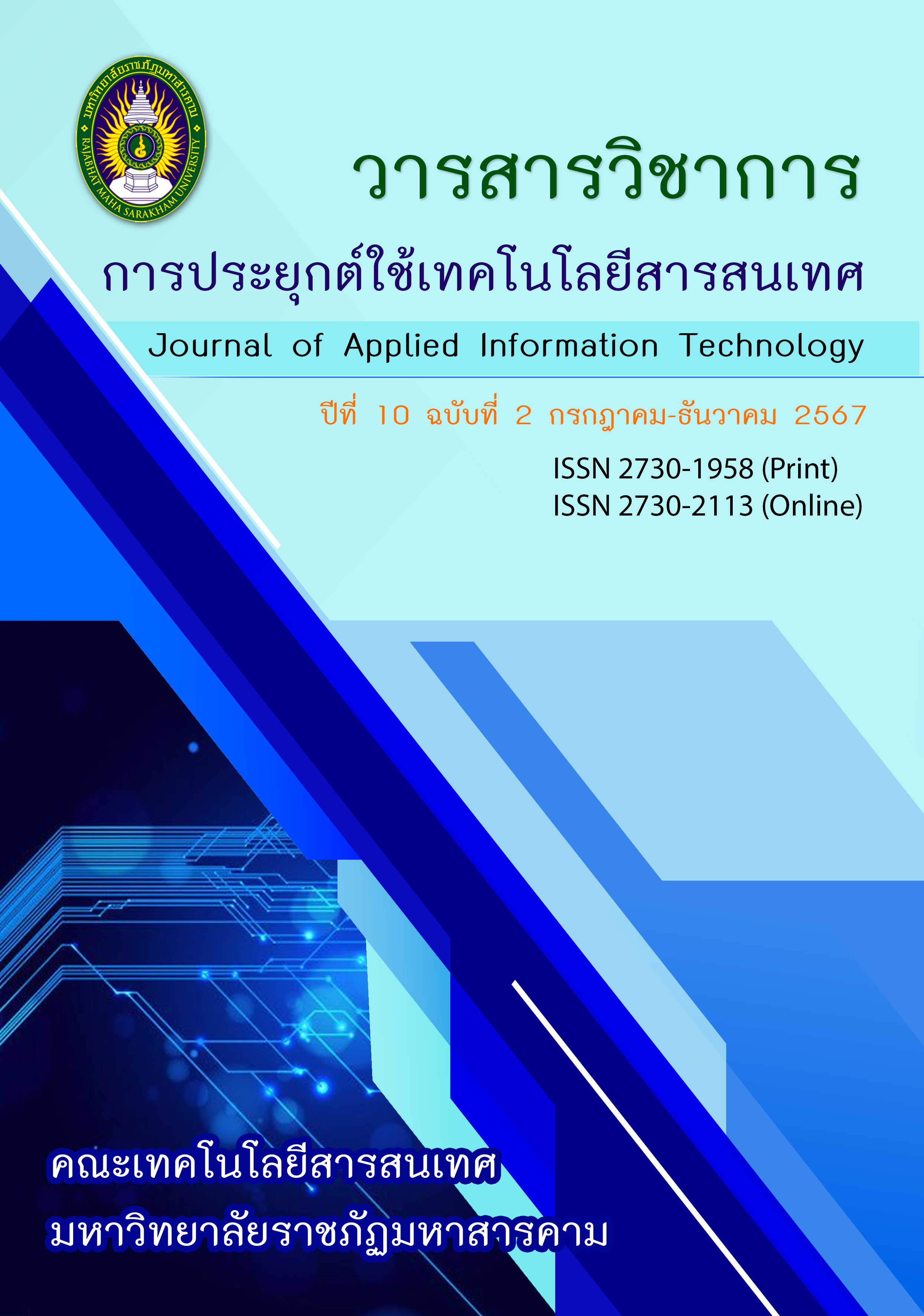Sand Transportation Management System for Industrial Sand Factories Using GPS Technology ระบบบริหารจัดการการขนส่งทรายสำหรับโรงงานผลิตทรายอุตสาหกรรมด้วยเทคโนโลยีจีพีเอส
Main Article Content
Abstract
The purposes of the research were to 1) develop a sand transportation management system for industrial sand factories using GPS technology 2) evaluate the system's efficiency, and 3) assess user acceptance of the system. The study involved 55 participants from industrial sand factories in Phra Nakhon Si Ayutthaya Province, comprising order management staff, transportation drivers, and order management supervisors. The system development followed the Waterfall Model that encompassing five stages: requirements analysis, system design, implementation, testing, and deployment.
The research findings showed that the developed system consisted of 5 modules, including customer information management, order management, route planning, transportation status tracking, and transportation performance analysis. The efficiency evaluation showed that the system performed at the "highest" level (mean score = 4.73), particularly in terms of accuracy in tracking trucks and user authentication, which scored the highest. Similarly, user acceptance was rated at the "highest" level (mean score = 4.55), with users highly satisfied with the system's ease of use and usefulness. In conclusion, the GPS-based sand transportation management system significantly improved transportation efficiency, reduced costs, and enhanced user satisfaction. The system demonstrates potential for further application and development in other industries.
Article Details
References
M. Oehler, K. Fisher, and B. Dorfman, “A Novel Multi-Modal System for Delivering Wet Frac Sand,” in Day 3 Thu, February 02, 2023, The Woodlands, Texas, USA: SPE, Jan. 2023, p. D031S008R005. doi: 10.2118/212349-MS.
Z. Yan and W. Yifan, “Application of GIS-aided INS/GNSS/GPRS navigation technology in logistics,” in 2024 36th Chinese Control and Decision Conference (CCDC), Xi’an, China: IEEE, May 2024, pp. 106–111. doi: 10.1109/CCDC62350.2024.10587837.
R. Verma, B. K. Singh, and F. Zahidi, “Management of GPS Tracking Systems in Transportation,” in Intelligent Transportation System and Advanced Technology, R. K. Upadhyay, S. K. Sharma, and V. Kumar, Eds., in Energy, Environment, and Sustainability. , Singapore: Springer Nature Singapore, 2024, pp. 251–263. doi: 10.1007/978-981-97-0515-3_11.
P. Trebuňa, M. Mizerák, M. Pekarčíková, M. Kliment, and M. Matiscsák, “Tracking of Trucks Using the GPS System for the Purpose of Logistics Analysis,” in Advances in Design, Simulation and Manufacturing VI, V. Ivanov, J. Trojanowska, I. Pavlenko, E. Rauch, and J. Piteľ, Eds., in Lecture Notes in Mechanical Engineering. , Cham: Springer Nature Switzerland, 2023, pp. 162–171. doi: 10.1007/978-3-031-32767-4_16.
V. Sevidova, Ye. Salnikov, and O. Kalinichenko, “APPLICATION OF DIGITAL TECHNOLOGIES IN THE DELIVERY OF CARGO IN INTERNATIONAL TRAFFIC,” Munic. Econ. Cities, vol. 3, no. 177, pp. 200–205, May 2023, doi: 10.33042/2522-1809-2023-3-177-200-205.
O. Lebedeva, J. Poltavskaya, and V. Gozbenko, “Effectiveness of the Implementation of Information Technologies in Solving Problems of Transport and Logistics Sector,” in XIV International Scientific Conference “INTERAGROMASH 2021", vol. 246, A. Beskopylny and M. Shamtsyan, Eds., in Lecture Notes in Networks and Systems, vol. 246. , Cham: Springer International Publishing, 2022, pp. 294–300. doi: 10.1007/978-3-030-81619-3_33.
Alfito Darryl Ramadhan, Rafa Mutiara Negara, Reiza Wienda Azzahra, Bagus Rahmadi, and Denny Oktavina Radianto, “Peran Teknologi Informasi dalam Transformasi di Industri Perkapalan,” Globe Publ. Ilmu Tek. Teknol. Kebumian Ilmu Perkapalan, vol. 2, no. 2, pp. 30–51, Apr. 2024, doi: 10.61132/globe.v2i2.253.
Ms. D. B. Chavan, Mr. A. S. Jadhav, Mr. A. D. Patil, Mr. S. R. Patil, Mr. P. K. Gujare, and Mr. S. S. Patil, “Transport Management System Application,” Int. J. Adv. Res. Sci. Commun. Technol., pp. 190–193, Apr. 2024, doi: 10.48175/IJARSCT-17434.
M. H. Sidram, L. V, C. M, H. H C, and R. M, “GPS-Guided, Solar-Powered AGVs for Streamlined Industrial Logistics,” in 2024 International Conference on Electronics, Computing, Communication and Control Technology (ICECCC), Bengaluru, India: IEEE, May 2024, pp. 01–07. doi: 10.1109/ICECCC61767.2024.10593999.
E. Bø and C. Mjøsund, “Use of GPS-data to improve transport solutions in a cost and environmental perspective,” Transp. Res. Interdiscip. Perspect., vol. 13, p. 100557, Mar. 2022, doi: 10.1016/j.trip.2022.100557.
P. Bernat, “GPS Technology Application as a Tool of Streamlining the Operations of a Transport Business and Economic Analysis,” Appl. Mech. Mater., vol. 791, pp. 96–101, Sep. 2015, doi: 10.4028/www.scientific.net/AMM.791.96.
P. Chaowasakoo, C. Leelasukseree, and W. Wongsurawat, “Introducing GPS in fleet management of a mine: impact on hauling cycle time and hauling capacity,” Int. J. Technol. Intell. Plan., vol. 10, no. 1, p. 49, 2014, doi: 10.1504/IJTIP.2014.066711.
R. Verma, “Enhancing Supply Chain Visibility and Security: GPS-Based Smart Locks in Trucks,” in 2023 International Conference on Innovative Computing, Intelligent Communication and Smart Electrical Systems (ICSES), Chennai, India: IEEE, Dec. 2023, pp. 1–5. doi: 10.1109/ICSES60034.2023.10465423.
E. Žunić, S. Delalić, and D. Đonko, “Adaptive multi-phase approach for solving the realistic vehicle routing problems in logistics with innovative comparison method for evaluation based on real GPS data,” Transp. Lett., vol. 14, no. 2, pp. 143–156, Feb. 2022, doi: 10.1080/19427867.2020.1824311.
C. Y. Lam and W. H. Ip, “An Integrated Logistics Routing and Scheduling Network Model with RFID-GPS Data for Supply Chain Management,” Wirel. Pers. Commun., vol. 105, no. 3, pp. 803–817, Apr. 2019, doi: 10.1007/s11277-019-06122-6.
O. Shevchuk, O. Desyatnyuk, V. Voitseshyn, M. Bryk, and V. Muravskyi, “Control and Accounting of the Transportation Services Self-cost using GPS,” in 2020 10th International Conference on Advanced Computer Information Technologies (ACIT), Deggendorf, Germany: IEEE, Sep. 2020, pp. 631–634. doi: 10.1109/ACIT49673.2020.9208973.
Nongmanee, P., & Khumbun, R. (2017). Increasing the efficiency of goods transportation: A case study of Dynamic Satcom Co., Ltd. [Master's thesis, Dhurakij Pundit University, Faculty of Business Administration]. (in Thai).
Pitaksakulthaworn, K., & Team. (2021). Design and development of an automated vehicle positioning system for tracking transportation of goods by trucks. Mahachulalongkornrajavidyalaya Journal, 8(7), 1–15. (in Thai).
J. Holguín-Veras, J. C. Amaral, and C. Rivera-Gonzalez, “Using GPS Data to Assess the Effectiveness of Freight Demand Management Strategies,” Transp. Res. Procedia, vol. 79, pp. 21–28, 2024, doi: 10.1016/j.trpro.2024.03.005.


